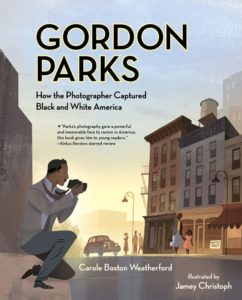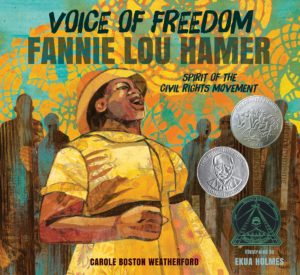Join us for another Library After Hours event! Meet a three-time Caldecott Honor author and a multi-talented illustrator and spoken word artist all in one presentation. Carole B. Weatherford will deliver a lively presentation tracing rap’s roots in African-American oral traditions and Jeffery Weatherford shares techniques and technology you can use to create your own raps.
This live virtual event will be on Friday, February 5, 2021, at 7-8 p.m. Register now or watch the playback of the program here.
The Charles County Public Library has many of Carole Boston Weatherford’s books, including The Roots of Rap: 16 Bars on the 4 Pillars of Hip-Hop, illustrated by Frank Morrison, and You Can Fly: the Tuskegee Airmen, illustrated by Jeffery Weatherford. Be sure to check out the fantastic works of Carole Boston Weatherford, ten of which are highlighted below. All summaries have been provided by the publishers.
Be a King: Dr. Martin Luther King Jr.’s Dream and You, illustrated by James E. Ransom
Featuring a dual narrative of the key moments of Dr. King’s life alongside a modern class as the students learn about him, Carole Weatherford’s poetic text encapsulates the moments that readers today can reenact in their own lives. See a class of young students as they begin a school project inspired by Dr. Martin Luther King Jr. and learn to follow his example, as he dealt with adversity and never lost hope that a future of equality and justice would soon be a reality. As times change, Dr. King’s example remains, encouraging a new generation of children to take charge and change the world . . . to be a King.
Box: Henry Brown Mails Himself to Freedom, illustrated by Michele Wood
Henry Brown wrote that long before he came to be known as Box, he “entered the world a slave.” He was put to work as a child and passed down from one generation to the next — as property. When he was an adult, his wife and children were sold away from him out of spite. Henry Brown watched as his family left bound in chains, headed to the deeper South. What more could be taken from him? But then hope — and help — came in the form of the Underground Railroad. Escape!
Freedom in Congo Square, illustrated by R. Gregory Christie
- A 2017 Caldecott Honor Book
- A 2017 Coretta Scott King Illustrator Honor Book
As slaves relentlessly toiled in an unjust system in 19th century Louisiana, they all counted down the days until Sunday, when at least for half a day they were briefly able to congregate in Congo Square in New Orleans. Here they were free to set up an open market, sing, dance, and play music. They were free to forget their cares, their struggles, and their oppression. This story chronicles slaves’ duties each day, from chopping logs on Mondays to baking bread on Wednesdays to plucking hens on Saturday, and builds to the freedom of Sundays and the special experience of an afternoon spent in Congo Square.
Book available
E-Book available on Overdrive
Read along video available on Hoopla
Gordon Parks: How the Photographer Captured Black and White America, illustrated by Jamey Christoph
His white teacher tells her all-black class, You’ll all wind up porters and waiters. What did she know? Gordon Parks is most famous for being the first black director in Hollywood. But before he made movies and wrote books, he was a poor African American looking for work. When he bought a camera, his life changed forever. He taught himself how to take pictures and before long, people noticed. His success as a fashion photographer landed him a job working for the government. In Washington DC, Gordon went looking for a subject, but what he found was segregation. He and others were treated differently because of the color of their skin. Gordon wanted to take a stand against the racism he observed. With his camera in hand, he found a way. Told through lyrical verse and atmospheric art, this is the story of how, with a single photograph, a self-taught artist got America to take notice.
Respect: Aretha Franklin, the Queen of Soul, illustrated by Frank Morrison
Aretha Franklin was born to sing. The daughter of a pastor and a gospel singer, her musical talent was clear from her earliest days in her father’s Detroit church. Aretha sang with a soaring voice that spanned more than three octaves. Her incredible talent and string of hit songs earned her the title “the Queen of Soul.” This Queen was a multi-Grammy winner and the first female inductee to the Rock and Roll Hall of Fame. And there was even more to Aretha than being a singer, songwriter, and pianist: she was an activist, too. Her song “Respect” was an anthem for people fighting for civil rights and women’s rights. With words that sing and art that shines, this vibrant portrait of Aretha Franklin pays her the R-E-S-P-E-C-T this Queen of Soul deserves.
The Roots of Rap: 16 Bars on the 4 Pillars of Hip-Hop, illustrated by Frank Morrison
The roots of rap and the history of hip-hop have origins that precede DJ Kool Herc and Grandmaster Flash. Kids will learn about how it evolved from folktales, spirituals, and poetry, to the showmanship of James Brown, to the culture of graffiti art and break dancing that formed around the art form and gave birth to the musical artists we know today. Written in lyrical rhythm by award-winning author and poet Carole Boston Weatherford and complete with flowing, vibrant illustrations by Frank Morrison, this book beautifully illustrates how hip-hop is a language spoken the whole world ’round, it and features a foreword by Swizz Beatz, a Grammy Award winning American hip-hop rapper, DJ, and record producer.
Schomburg: The Man Who Built a Library, illustrated by Eric Velasquez
Amid the scholars, poets, authors, and artists of the Harlem Renaissance stood an Afro-Puerto Rican named Arturo Schomburg. This law clerk’s life’s passion was to collect books, letters, music, and art from Africa and the African diaspora and to bring to light the achievements of people of African descent throughout the ages. When Schomburg’s collection became so big that it began to overflow his house (and his wife threatened to mutiny), he turned to the New York Public Library, where he created and curated a collection that was the cornerstone of a new Negro Division. A century later, his groundbreaking collection, known as the Schomburg Center for Research in Black Culture, has become a beacon to scholars all over the world.
Book available
E-Book available on Overdrive
Read along video available on Hoopla
Unspeakable: The Tulsa Race Massacre, illustrated by Floyd Cooper
Celebrated author Carole Boston Weatherford and illustrator Floyd Cooper provide a powerful look at the Tulsa Race Massacre, one of the worst incidents of racial violence in our nation’s history. The book traces the history of African Americans in Tulsa’s Greenwood district and chronicles the devastation that occurred in 1921 when a white mob attacked the Black community. News of what happened was largely suppressed, and no official investigation occurred for seventy-five years. This picture book sensitively introduces young readers to this tragedy and concludes with a call for a better future.
Voice of Freedom: Fannie Lou Hamer, The Spirit of the Civil Rights Movement, illustrated by Ekua Holmes
- A 2016 Caldecott Honor Book
- A 2016 Robert F. Sibert Honor Book
- A 2016 John Steptoe New Talent Illustrator Award Winner
Despite fierce prejudice and abuse, even being beaten to within an inch of her life, Fannie Lou Hamer was a champion of civil rights from the 1950s until her death in 1977. Integral to the Freedom Summer of 1964, Ms. Hamer gave a speech at the Democratic National Convention that, despite President Johnson’s interference, aired on national TV news and spurred the nation to support the Freedom Democrats. Featuring vibrant mixed-media art full of intricate detail, Voice of Freedom celebrates Fannie Lou Hamer’s life and legacy with a message of hope, determination, and strength.
You Can Fly: The Tuskegee Airmen, illustrated by Jeffery Boston Weatherford
From training days in Alabama to combat on the front lines in Europe, this is the story of the Tuskegee Airmen, the groundbreaking African-American pilots of World War II. In vibrant second-person poems, Carole Boston Weatherford teams up for the first time with her son, artist Jeffery Weatherford, in a powerful and inspiring book that allows readers to fly, too.















